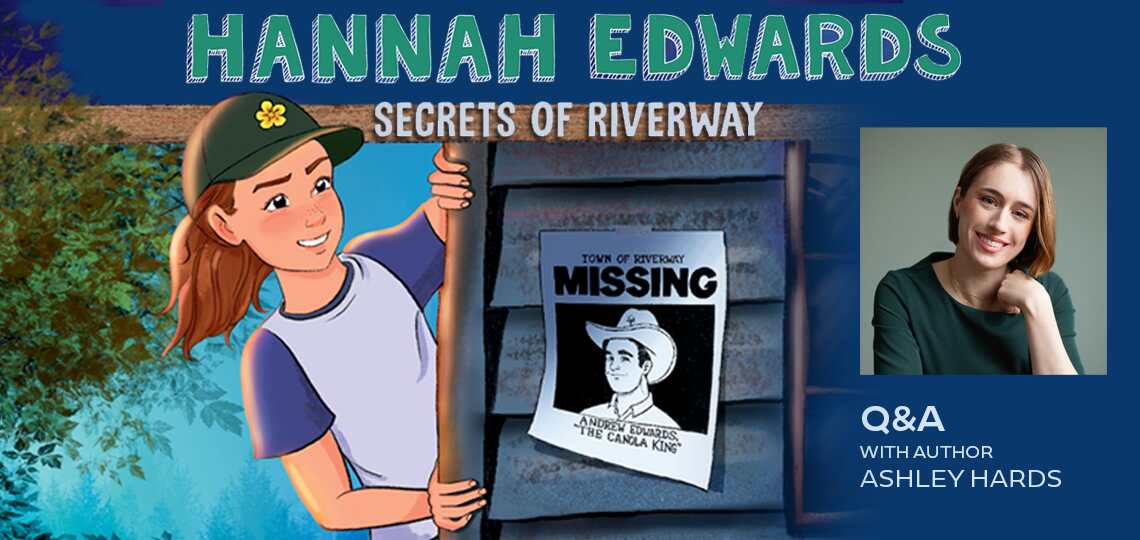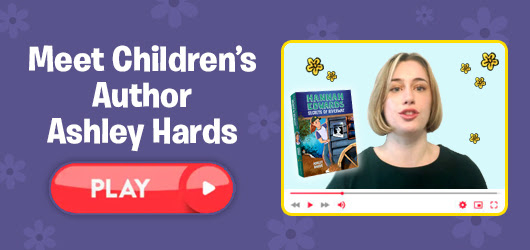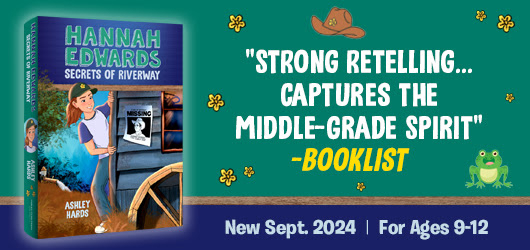Did Hamlet have ADHD? Explore in New Middle Grade Reimagining by Debut Ashley Hards
Children’s Book Editor Danielle Ballantyne Interviews Ashley Hards, Author of Hannah Edwards Secrets of Riverway
Children are desperate for accurate representation in their literature, but for too long, such efforts have not extended to neurodiverse communities. Author Ashley Hards is aware of this gap, and she wrote her sparkling mystery novel Hannah Edwards Secrets of Riverway as a partial answer. It draws on classic tropes (keep an eye out for those Shakespeare nods!) with a twist: its intrepid heroine, whose father has gone missing, has ADHD, and her search efforts are similarly unique. The result is a delightful middle grade novel whose ghost story pairs with a refreshing window into the lives of the neurodiverse.
Hoping to learn more about Ashley’s writing life and the creation of Hannah Edwards Secrets of Riverway, we asked Foreword‘s children’s book editor Danielle Ballantyne to connect with her for the following conversation.
This is your first published novel, but when did the storytelling bug first bite you?
If you ask my mom, she’d tell you that I was always writing stories—in second grade, I even described a school project as my “third novel.” (I don’t remember the other two.) Until recently, however, I always saw writing as a hobby. The storytelling bug really got a hold of me when I became a mountain-bike-camp coach for kids. I had to find unique ways to keep kids engaged—especially when many would rather be at home playing video games. The camp that I worked at had some preexisting lore about some mysterious abandoned cars in the forest. I adapted it to add a ruined (and cursed) house at the top of the hill—then kids really wanted to bike uphill and see it! After that experience, I knew that I wanted to keep engaging readers with fun stories and mysteries.
How have your personal experiences as a neurodiverse writer shaped Hannah Edwards and the town of Riverway?
The main way that my neurodiversity influenced this novel was in its formatting. Because of my ADHD, I occasionally have a hard time starting things. My brain sets up an expectation about what needs to be written—and how it should be written—which can result in writing paralysis. For example, I needed to describe the setting, but it felt nearly impossible to just sit down and describe the town. So, I imagined that I was Hannah—a young, frustrated girl tasked with writing a tourist brochure for school. Then, the chapter appeared! This technique of varying the text format allows the book to be multifaceted: it’s made up of transcripts of audio recordings, journal entries, Post-it notes, lists, and even an entire chapter in rhyme!
Your novel is a unique reimagining of Shakespeare’s Hamlet. How did you tackle balancing the play’s darker elements with age-appropriate details?
Hamlet, like many of Shakespeare’s works, definitely has some problematic elements, which was a huge factor that I considered as I approached this novel. To keep the book true to its source but also still age-appropriate, I focused on what I see as the “heart” of the play: Hamlet is a story about one man’s struggle to take action in the face of massive loss and uncertainty about the future.
Like Hamlet, Hannah Edwards encounters many struggles: she has to grapple with both her father’s disappearance and her increasing difficulties to control her own attention (and, by extension, how others perceive her). Unlike Hamlet, however, Hannah is less alone: her friends, Sam Castillo and Tim the Hall Monitor, are fully able to join in on the adventures. And Hannah’s mother genuinely loves her and wants to support her. Plus, Hannah is less cynical than Hamlet (and likes frogs a lot more). Adding these lighthearted elements allowed me to make Hamlet’s plot and themes more kid-friendly while still sticking to the spirit of the original work.
A Wild West town that time forgot, Riverway is a classic American small town in many ways: everyone knows everyone’s name but not their secrets. Was this setting personal for you at all?
I’m from a city—Calgary, Alberta—yet I feel very connected to rural communities in Southern Alberta. My family used to drive south on Highway 2 every weekend to visit our favorite ski hill (Castle Mountain Resort), and on the way, we’d pass through towns like Nanton, Claresholm, and Pincher Creek. I was fascinated by the unique history of these towns: Nanton’s historic grain elevator, for example, inspired the novel’s haunted Old Grain Mill; the joint Candy Store and Antique Shop inspired Jemma’s Gems and the Sweets Shoppe. Importantly, the community at Castle Mountain Resort inspired the people: everyone at Castle knows each other, and we used to pop by our friends’ cabins without any notice (which shows how safe the community was and still is). It was an honor to capture even a small part of this amazing experience in the fictional town of Riverway.
Your protagonist, Hannah, is neurodivergent. What advice would you give to authors who want to include neurodiverse characters but are uncertain how to do so in an authentic, respectful way?
The most important thing to do is to ask questions to a neurodivergent person. There is a lot of misinformation about ADHD in the world and on the internet. Learning about someone’s authentic experience can be the difference between reinforcing stereotypes or accurately representing others’ lived experiences. If you don’t know any neurodiverse people, a second option would be to read neurodiverse authors! They will give you a glimpse into what our life is really like.
Hannah struggles with many things throughout the novel, not the least of which is grief. How did you approach portraying such a difficult and complex topic for a younger audience?
Grief is such a difficult topic to write about, especially for a younger audience. I was tempted to shield readers from Hannah’s pain, but ultimately I didn’t because, as sad as it is to say, young people do experience grief! Often kids’ emotions are downplayed as being less important than those of adults and this makes things like losing a loved one even harder. The first loss that I remember happened when my grandfather Poppy passed away when I was seven. I missed him a lot, and my brother (who was four at the time) was annoying me because he kept asking what would happen to Poppy. I angrily told him, “Poppy will be eaten by worms!” My brother jumped into the empty grave and announced, “That’s not true! There’s no worms here!” which made us all laugh. To me, this pairing of sadness and humor is key: Hannah Edwards misses her dad, but it doesn’t stop her from fighting for the good in the world—like trying to save the town’s dying river and making sure that justice is served.
What do you hope readers take away from Hannah Edwards Secrets of Riverway?
I hope that readers will empathize with Hannah’s struggles as a girl with ADHD. For readers with ADHD, having a realistic depiction of someone with this disorder can make them feel less alone. It’s like: see, Hannah has ADHD but she still does everything other kids do—just in a different way! For readers without ADHD, I hope Hannah can help them understand certain ADHD behaviors. When you just see the result of ADHD—for example, someone being overly chatty in class or never sitting still—it can be easy to pigeonhole people with ADHD as annoying or disruptive. Hannah’s journal shows us that these behaviors aren’t malicious—they’re just ways of coping with an abundance of energy and the excitement of trying to solve a mystery.
Are there any other projects you’re currently working on? Any plans to catch up with Hannah Edwards for another adventure?
Right now, my biggest project has been brainstorming new ways to teach writing at Desautels Faculty of Management at McGill University in Canada. I’m also finishing a cross-stitch pattern from my great-grandmother. But I’m definitely not done with Riverway—after all, we need to see what happens to the town when the river does flow.
Danielle Ballantyne




